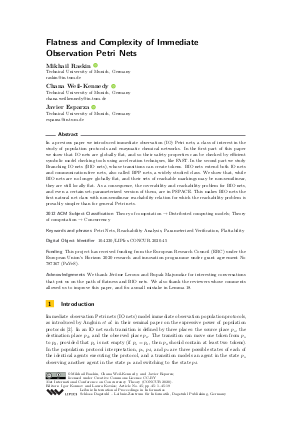@InProceedings{raskin_et_al:LIPIcs.CONCUR.2020.45,
author = {Raskin, Mikhail and Weil-Kennedy, Chana and Esparza, Javier},
title = {{Flatness and Complexity of Immediate Observation Petri Nets}},
booktitle = {31st International Conference on Concurrency Theory (CONCUR 2020)},
pages = {45:1--45:19},
series = {Leibniz International Proceedings in Informatics (LIPIcs)},
ISBN = {978-3-95977-160-3},
ISSN = {1868-8969},
year = {2020},
volume = {171},
editor = {Konnov, Igor and Kov\'{a}cs, Laura},
publisher = {Schloss Dagstuhl -- Leibniz-Zentrum f{\"u}r Informatik},
address = {Dagstuhl, Germany},
URL = {https://drops.dagstuhl.de/entities/document/10.4230/LIPIcs.CONCUR.2020.45},
URN = {urn:nbn:de:0030-drops-128574},
doi = {10.4230/LIPIcs.CONCUR.2020.45},
annote = {Keywords: Petri Nets, Reachability Analysis, Parameterized Verification, Flattability}
}

 Creative Commons Attribution 3.0 Unported license
Creative Commons Attribution 3.0 Unported license















